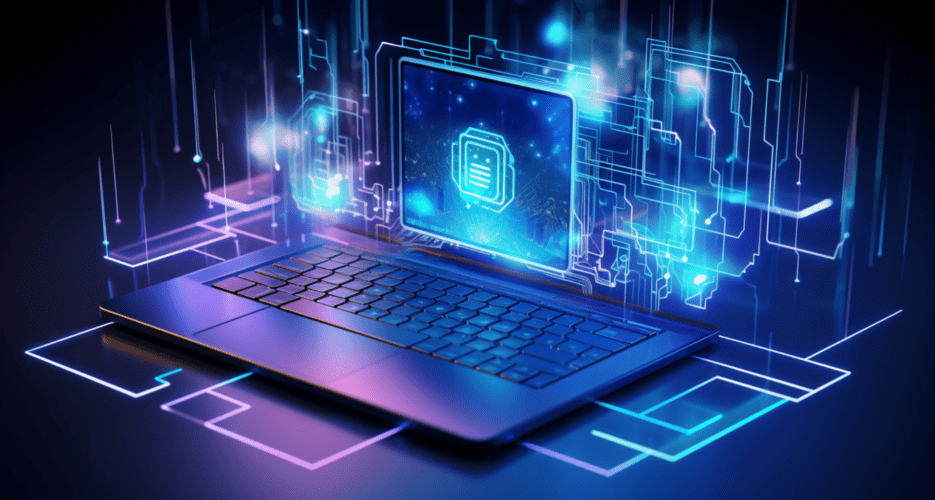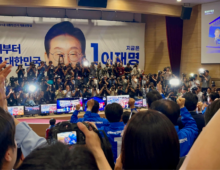|
Analysis How the US-ROK alliance can meet the challenges of artificial intelligenceFrom North Korean hackers to Chinese military enhancements, the allies are expanding beyond conventional deterrence Arius DerrNovember 2, 2023  An illustration of a futuristic cybersecurity environment | Image: Korea Pro In a bid to strengthen American influence in artificial intelligence (AI), U.S. President Joe Biden signed an executive order on Oct. 30 outlining new safety standards, enhanced user protections and initiatives to spur innovation. The White House emphasized its intent to collaborate with international allies and partners to shape a robust framework guiding AI’s evolution and application. The U.S.-ROK alliance emerges as a significant pillar in this strategy, positioning itself as a growing force in the Korean Peninsula’s AI landscape. The alliance “seems well positioned to apply resources to bolstering allied cybersecurity,” James E. Platte, an associate professor with the U.S. Army School of Advanced Military Studies, told Korea Pro. Under the leadership of President Biden and South Korean President Yoon Suk-yeol, the past 18 months have witnessed significant changes in the U.S.-ROK alliance, addressing the ever-evolving challenges in the region. While the security arrangement’s primary goal remains to deter conventional threats from North Korea, the White House’s integrated deterrence strategy is recalibrating the U.S.-ROK alliance’s focus. The alliance now acknowledges a broader spectrum of national security threats, leading to an expanded toolkit to counter challenges, notably in cybersecurity. Dennis Desmond, a lecturer at the University of the Sunshine Coast, emphasizes the significance of a holistic strategy. “An integrated approach to securing important trade, economic, diplomatic and defense information with a unified response to any threats will be important to deterring cybercrime, cyberwarfare and cyberespionage efforts,” Desmond told Korea Pro. Echoing this sentiment, Platte stresses the importance of mutual understanding among allies. “Integrating should mean coming to common understandings of deterrence and how to operationalize deterrence using all available allied tools,” he explained. BUILDING A FOUNDATION The U.S. and South Korea adopted the Strategic Cybersecurity Cooperation Framework in April, strengthening ties across various information sectors and promoting synergy between the two countries’ respective strengths. The two sides introduced the framework at a summit as part of a comprehensive joint statement that, similar to the Pentagon’s 2023 cyber strategy document, promotes forms of integrated deterrence that may not represent major departures from what both are already doing “to ensure interoperability and security in joint operations” in cyberspace, according to Jenny Jun, a research fellow at the Center for Security and Emerging Technology in Washington. Soyoung Kwon, the director of George Mason University Korea’s Center for Security Policy Studies, praises the framework for heralding a “more systematic and proactive approach” in jointly tackling the escalation in cyber threats. She told Korea Pro that the two countries have set the stage for broader cooperation. This encompasses “deterring cyber foes, increasing the cybersecurity of critical infrastructure, combatting cybercrimes and ensuring the security of cryptocurrency and blockchain applications.” Kwon posits that these measures are part of mutual endeavors to elevate the U.S.-ROK partnership into a “comprehensive global strategic alliance.” “It will also serve as the basis of enhancing cybersecurity cooperation with the international community to counteract malicious cyber activities and to work toward maintaining safe and resilient order in cyberspace.”  South Korean President Yoon Suk-yeol attends the Dialogue with Young White Hackers event, Oct. 12, 2023 | Image: ROK Presidential Office EVOLVING THREATS Today’s most dynamic and sophisticated threats confronting the U.S. and South Korea emerge from the digital realm. Both nations understand that their decadeslong security arrangement, which previously centered on defending against ground invasions, demands adaptation. The essence of the U.S.-ROK alliance is expanding to deter virtual intrusions, mitigate disinformation campaigns, counter-espionage and shield sensitive data. “The allies should come to a better-shared understanding of what in the data and cybersecurity realms represent strategic threats to the allies and focus efforts on those threats,” Platte explained. The misuse of AI presents an alarming challenge. Malicious actors can harness AI to optimize hacking operations, accelerate the analysis of large data sets, enhance decision-making and heighten operational efficiency. For instance, North Korea deploys thousands of “cyber-warfare specialists,” launching highly sophisticated phishing schemes via social media, targeting South Korean civil infrastructure and orchestrating blockchain thefts netting the regime hundreds of millions of dollars. North Korea’s AI proficiency is likely amplified through exchanges with China. Beijing’s massive investment in military AI applications presents “an important model for the regime’s sense of what is technologically feasible,” Jun and others concluded in a 2022 think tank report. China’s People’s Liberation Army has invested significant resources in projects like unmanned aerial vehicles, advanced targeting systems, and AI-enhanced logistical plans. Such AI integrations enable military strategists to promptly assimilate, assess and respond to real-time data from multiple wartime domains. Further, China’s vast online censorship, often dubbed the Great Firewall, stands as a testament to how the Chinese Communist Party harnesses AI and other digital capabilities. The Chinese online sphere is highly curated, often dominated by intense nationalism and adulations of Xi Jinping. However, China is not the only country from which the U.S.-ROK alliance must fortify its cybersecurity posture. Russia has showcased its cyber prowess, too. The Kremlin’s digital brigades played a strategic role in Eastern Europe, launching cyber offensives against Ukraine’s energy infrastructure, logistics, communication systems and more. Russian cyber experts have also deployed malware such as NotPetya and “Snake” to hijack user devices for espionage or extortion. While Russia may lag behind China in leveraging AI, it excels in disseminating mass disinformation, a tactic termed “flooding the zone.” Such campaigns aim to undermine trust in key institutions like the U.S.-ROK alliance, thereby making it difficult for allies to promote cohesive messaging that resonates with the public. Desmond warns of the challenges posed by advanced language models like ChatGPT and AI-driven image generators like Midjourney in the battle against disinformation. Yet the U.S.-ROK alliance is not without its strategic leverage. By harnessing the same AI tools their adversaries employ, they can, as Platte suggests, utilize machine learning to “counter adversary information campaigns through a better understanding of adversary methods and intentions.” This information, Platte explained, “could be used to gain decisive advantage over an adversary like North Korea.”  An illustration of a soldier looking at his PDA | Image: Korea Pro NEW TERRITORY The U.S. and ROK are intensifying their cybersecurity efforts. In 2021, they established a cyber working group “focused on enhancing cooperation among law enforcement and homeland security agencies.” This has taken the form of joint cybersecurity advisories, most recently in June 2023 which warned of “social engineering” efforts targeting journalists and researchers working on North Korea-related issues. South Korea has also introduced sanctions targeting cybercrime, aligning with U.S. Treasury actions against individuals involved in cryptocurrency theft. Beyond the Strategic Cybersecurity Cooperation Framework, the two countries have participated in multilateral cyber exercises, launched the Next Generation Critical and Emerging Technologies Dialogue and pledged to enhance cyber cooperation through various consultative bodies. South Korea’s commitment is further evident in its recent initiatives: launching its first cybersecurity strategy in 2019, transitioning its Armed Forces Cyber Command into the Cyber Operations Command and boosting research and training in cybersecurity. MORE TO DO While efforts are underway, experts suggest a lack of institutionalized coordination remains between the U.S. and South Korea. Enhancing the alliance requires a systematic approach to tackling AI-driven threats. “There needs to be a greater partnership and cooperation between government, academia and the private sector” to share information across borders, Desmond of Sunshine Coast told Korea Pro. Platte emphasizes the importance of human deliberation in cyber deterrence. “How information is used for strategic, operational and tactical effects should be decided through human debate, and then machine learning systems can improve utilization of information campaigns,” he told Korea Pro. Desmond added that Australia’s collaboration with the U.S. provides a roadmap for South Korea. Australia’s commitment to cross-sector coordination, particularly through information sharing and analysis centers, institutionalizes the regular exchange of vital cyber defense information. A persistent challenge lies in allocating resources effectively for cybersecurity threats. Writing in 2020 for The Cyber Defense Review, Platte argued that cyber attacks lay on a spectrum between “low-level” and “strategic,” with the former more likely falling under the sole responsibility of South Korea while the latter requires a unified response from the alliance. Defense strategists face the challenge of gauging the severity of a cyberattack in real time and then deciding the appropriate resource deployment level. However, determining if cyber threats merit an alliance-level response and preventing their occurrence will be pivotal for the U.S.-ROK alliance. “The biggest challenge for the alliance may be coming to common understandings of how best to define, operationalize and utilize the cyber domain,” Platte told Korea Pro. “The alliance’s resources must be matched with integrated alliance thinking to properly meet new cybersecurity challenges.” Edited by John Lee In a bid to strengthen American influence in artificial intelligence (AI), U.S. President Joe Biden signed an executive order on Oct. 30 outlining new safety standards, enhanced user protections and initiatives to spur innovation. The White House emphasized its intent to collaborate with international allies and partners to shape a robust framework guiding AI’s evolution and application. The U.S.-ROK alliance emerges as a significant pillar in this strategy, positioning itself as a growing force in the Korean Peninsula’s AI landscape. Get your
|
|
Analysis How the US-ROK alliance can meet the challenges of artificial intelligenceFrom North Korean hackers to Chinese military enhancements, the allies are expanding beyond conventional deterrence  In a bid to strengthen American influence in artificial intelligence (AI), U.S. President Joe Biden signed an executive order on Oct. 30 outlining new safety standards, enhanced user protections and initiatives to spur innovation. The White House emphasized its intent to collaborate with international allies and partners to shape a robust framework guiding AI’s evolution and application. The U.S.-ROK alliance emerges as a significant pillar in this strategy, positioning itself as a growing force in the Korean Peninsula’s AI landscape. © Korea Risk Group. All rights reserved. |











